
24 Jul 2021
Class act rowing in day two heats at the Tokyo Olympic rowing regatta
A small head wind meant that no record times would happen today for day 2 heats at the Sea Forest Waterway in Tokyo. Home of the Olympic rowing regatta. The water was relatively flat and temperatures were in the high 20s degrees Celsius.
Women’s pair (W2-) – Heats
The three heats here meant that a top three finish was needed for a direct path to the semifinals. In Heat One it was the Canadians that got out quickly. Caileigh Filmer and Hillary Janssens of Canada haven’t raced internationally since medalling at the 2019 World Championships. Since then Filmer has had a bike crash and come back to rowing after a break. Coming into the middle of the race the Canadians continued to lead with Italy, rating one pip higher at 37, sitting in second. Romania and Greece followed very closely duking it out for the third place. The United States had had a rather slow start but now looked like they were edging back.
Romania (Iuliana Buhus and Adriana Ailincai) then got firmly into third and closed on Italy as Canada continued to lead. The Romanian pair had taken third at World Cup III this season, while Italy finished sixth at the same regatta. Romania then overtook Italy and went after Canada. Filmer and Janssens upped their stroke rate by one to hold off Romania. The Romanians started to sprint. Canada had just enough to hold them off.
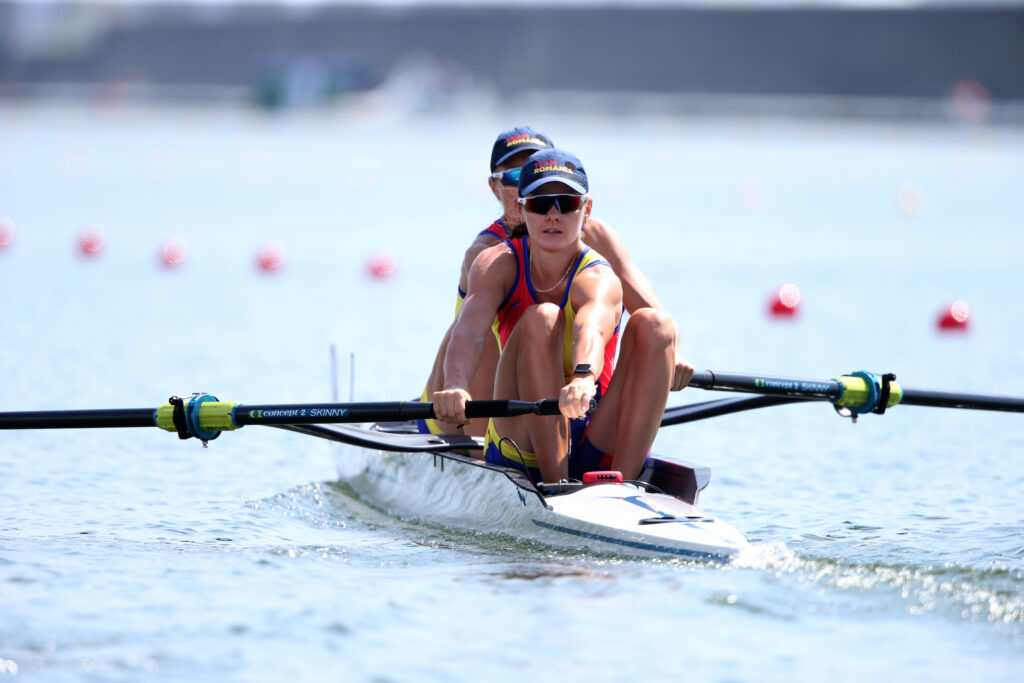
All eyes were on the British duo in Heat Two. Two-time Olympic Champion Helen Glover of Great Britain has returned to rowing following a post-Rio retirement. She’s started a family and then used lockdown to start her rowing training. Great Britain and China had the fastest start, rating over 40 strokes per minute. But the first to show was Australia’s McIntyre and Morrison, though there was nothing in it as Glover and Swann were right with them. ROC’s Vasilisa Stepanova and Elena Oriabinskaia were also in the mix. The ROC crew qualified through the Final Olympic Qualification Regatta in May.
These three boats were practically neck-and-neck at the half way point. Meanwhile China was a long way back. McIntyre and Morrison took silver in 2019 and will be racing later today in their country’s four. Australia then got a half boat over ROC and Great Britain. Stepanova and Oriabinskaia had got ahead of Great Britain as the boats came into the final 500m. All of these crews were in qualifying spots and no one was doing any massive sprint with the Australians going to 33 strokes per minute.
Heat Three had the reigning World Champions, Kerri Gowler and Grace Prendergast, of New Zealand lining up. They hadn’t raced internationally since August 2019 at the World Champs and it would be interesting to see what the two years in between had done for their boat speed. Ireland got away at a 42 stroke rate speed, but it was Gowler and Prendergast that had the edge right from the start. And once there, they never looked back. Following in second was Denmark’s new combination of Fie Udby Erichsen and Hedvig Rasmussen. Denmark qualified through the Final Olympic Qualification Regatta and Erichsen comes from single sculling, which included a 2012 Olympic medal. Rasmussen medalled in the pair at the Rio Olympics.
The race then became very spread out with the New Zealanders going to an open water lead. Denmark held second but the fight for third between Spain and Ireland looked rather intense. The final qualifiers were definitely not yet decided. The Spanish (Cid and Diaz Rivas) were just behind the Irish. Then Spain did an almighty sprint and got ahead of Ireland and closed on Denmark. Spain qualified along with Denmark and New Zealand. Gowler and Prendergast now will prepare for racing in the women’s eight heat later today.
Qualifiers: CAN, ROU, ITA, AUS, ROC, GBR, NZL, DEN, ESP
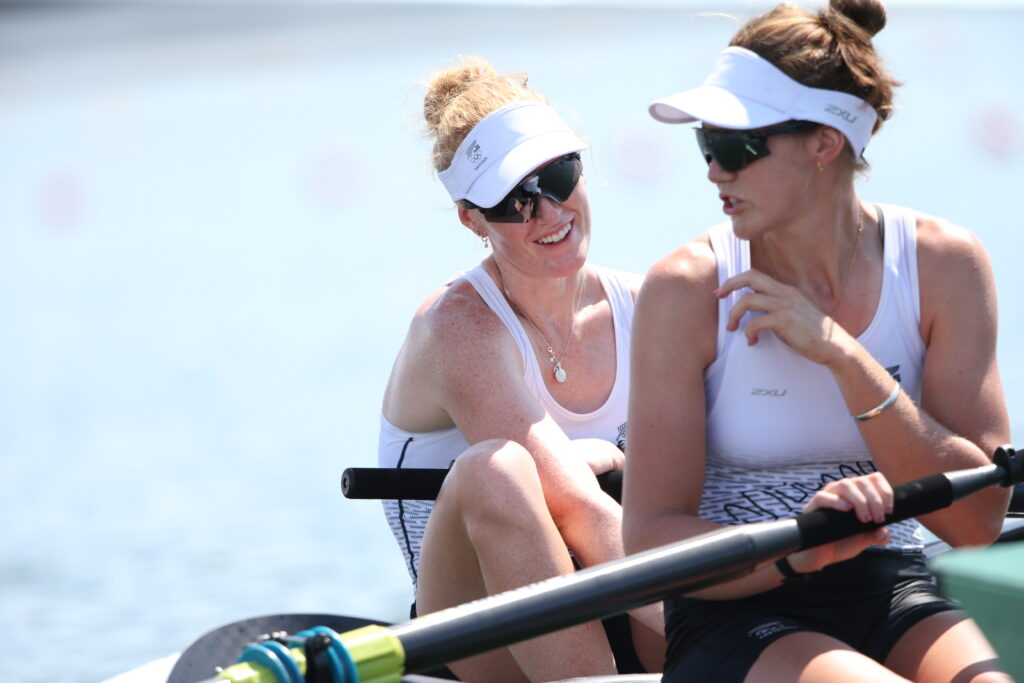
Men’s pair (M2-) – Heats
Three heats lining up meant the top three in each heat would get to go directly to the semifinals. Romania shot out at the start of Heat One and their rate hit 47. But margins were close and the Netherlands, Spain, South Africa and Serbia where right on them at the first 500m mark. Marius Cozmiuc and Ciprian Tudosa of Romania continued to hold a small lead. They finished third at World Cup III and are the 2021 European Champions. The Dutch then overtook Romania going through the middle of the race.
But Romania wanted first and they pushed back. In the final sprint the Dutch weren’t giving up with Romania taking their rating up to 40, then 42, and topping out at 44. Romania finished in the lead with Serbia getting the better of South Africa and Spain to take third. The Netherlands attempted a great sprint against Romania, but were out-sprinted to finish second.
Heat Two saw a battle between Australia and Italy with Australia out in front, but Italy giving them no margin. Sam Hardy and Joshua Hicks of Australia are both very experienced rowers although they hadn’t raced internationally since 2019 when they were the World bronze medallists. The Italians of Giovanni Abagnale and Marco Di Costanzo finished fourth at World Cup II and World Cup III. Following in third was New Zealand. The race turned into a real procession as Australia pulled further and further away from Italy, with the Italians pulling away from New Zealand’s new pair of Robertson and Jones. Australia did not need to sprint the last 500m and they cruised home for the win.
It was a fast start for Croatia and Denmark in Heat Three. All eyes were on Croatia’s Sinkovic brothers who are the reigning World and European Champions and Olympic Champions from the men’s double. But it was Denmark that got to the first 500m in the lead. It took until the 750m mark for Croatia to get the lead and they looked effortless in doing it. Following in third was Canada.
The Sinkovic brothers continued to push on and they got a clear water lead going through the third 500m. Denmark’s Vystavel and Sutton remained in second. They qualified from the Final Olympic Qualification Regatta and were 8th at the 2021 European Championships. In third and racing internationally for the first time in two years were the Canadians – Langerfeld and McCabe – who could not pull in the Danes.
Qualifiers: ROU, NED, SRB, AUS, ITA, NZL, CRO, DEN, CAN
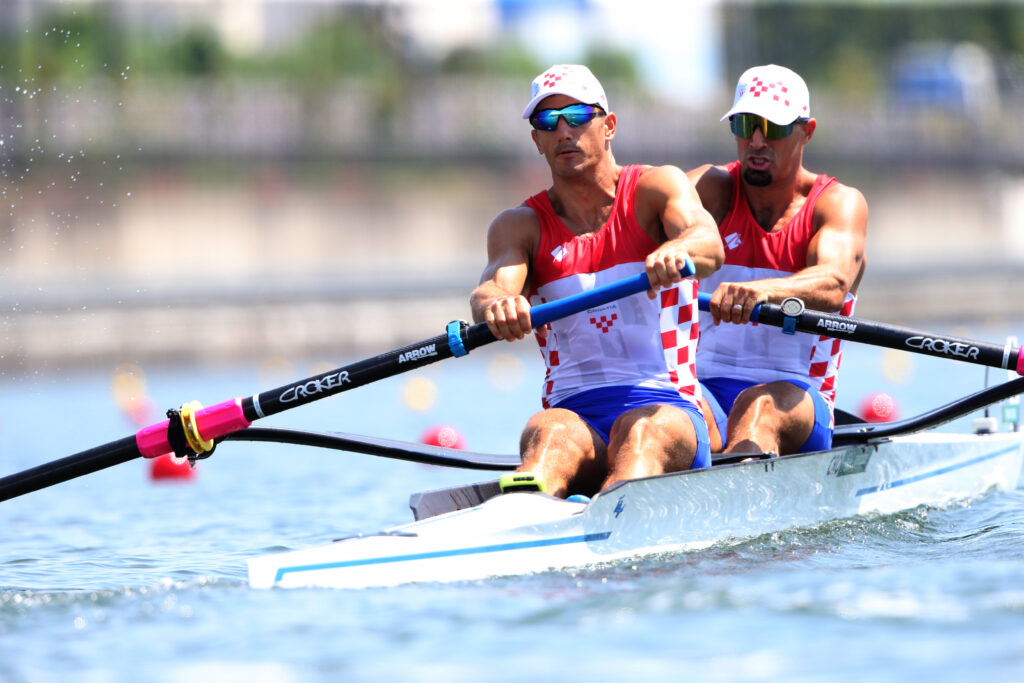
Lightweight women’s double sculls (LW2x) – Heats
There were three heats in this boat class lining up and their goal was to be in a top two position for a direct path to the semifinals. At the start of Heat One it was Italy with a small margin. But there was nothing in it at the first 500m mark with just over a second separating the top four boats. Italy and France – side-by-side – were setting the pace, with Italy’s Rodini and Cesarini just in front. Meanwhile on the other side of the course, the United States crew of Reckford and Sechser were giving it their all to get into third. Reckford and Secher qualified by winning the Final Qualification Regatta in May. The US then picked up the rate and they were solidly in third at the 1500m mark. The sprint was on and France (Tarantola and Bove) had taken the lead. The French finished third at World Cup II and won at World Cup I this season. Italy upped their stroke rate and so did the US. The US were closing on Italy. Italy was at 41, the Americans were at 38. It was very close. At the line France had won. Italy took second and the US were very close in third.
Heat Two had the Dutch lining up. They set a new World Best Time at World Cup III this year – the only crew to set a World Best Time so far this year. Keijser and Paulis of the Netherlands were definitely the crew to beat. Jumping out at 46 strokes per minute at the start was Vietnam. But Keijser and Paulis were quicker and had the lead with 100m rowed. Vietnam and Japan were neck-and-neck for second.
With that the Dutch took off and with every stroke moved away from the field. Then Canada started to move up. The Canadians had got their Olympic spot earlier this year after the World Champion New Zealand crew pulled out when Zoe McBride announced her retirement in March. Paulis and Keijser now had a clear water lead. Paulis is the Olympic Champion from Rio in this event. Canada’s Moffatt and Casson had now got into second ahead of Japan’s Tomita and Oishi. The Japanese duo had finished sixth at World Cup II this season and there are high hopes on this boat.
The race was now a procession and with 500m left the order had been decided. Japan would have to go to the repechage.
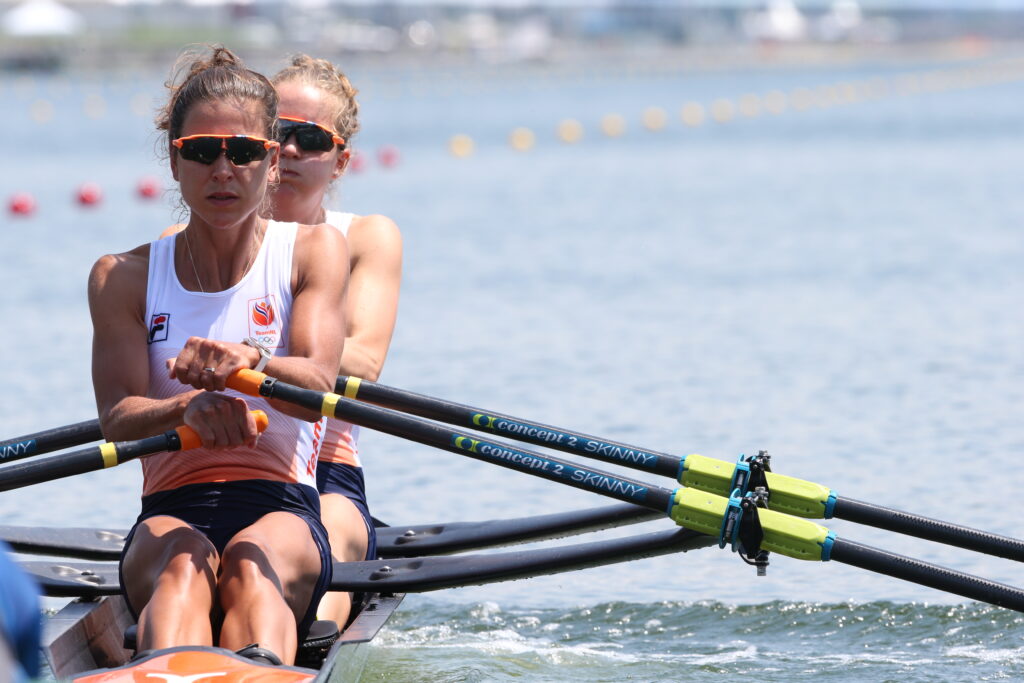
Heat Three was underway with the potential favourites for this race being Romania and Great Britain. They all got off to a clean start with Austria rating the highest of 44 strokes per minute. Great Britain took the lead with ROC coming through in second followed by Belarus who had the edge on Romania. Emily Craig and Imogen Grant of Great Britain finished first at World Cup II this year. Then ROC’s Lebedeva and Botalova took the lead. The Russian duo were fourth at World Cup II, with Romania finishing second at this event.
Then Romania began to move. They overtook Belarus and went after Great Britain, they were gaining with every stroke. Seeing this coming Great Britain sprinted and overtook ROC. Romania was still down on ROC and out of qualification. There was 300m left to row and ROC was suffering. Romania got into second and closed on Great Britain who did not look worried about being overtaken by Romania. Cozmiuc and Beleaga overtook Great Britain to win the race. Romania had recorded the fastest qualifying time of 7:01.
Qualifiers: FRA, ITA, NED, CAN, ROU, GBR
Lightweight men’s double sculls (LM2x) – Heats
This boat class had three heats with the goal of a top two finish for a direct path to the semifinals. At the start of Heat One it was Italy who had the highest rating, with a 44 strokes per minute from Ruta and Oppo. But Germany had the most pace at the start and they got to the 500m mark just a fraction ahead of Italy. This was going to be an Italian – German battle and already these two boats were moving away from the rest of the field.
In the German boat was Jonathan Rommelmann and Jason Osborne, who finished third at World Cup II. In that same race Italy was fourth. Osborne was planning to turn to professional cycling after the 2020 Olympics. But with the Olympic delay, he now plans to do so after this regatta. Italy and Germany continued to go head-to-head and then Germany, rating 38, made a move going through the third 500m. The move worked and the Germans got a boat length over Italy. The Germans wanted to win! Italy was firmly in second and they did not look like they were going to try and push back into first. Rommelmann and Osborne looked incredibly strong and impressive as they took their boat home finishing in a time of 6:21. This was just 11 seconds off the Olympic Best Time in head wind conditions.
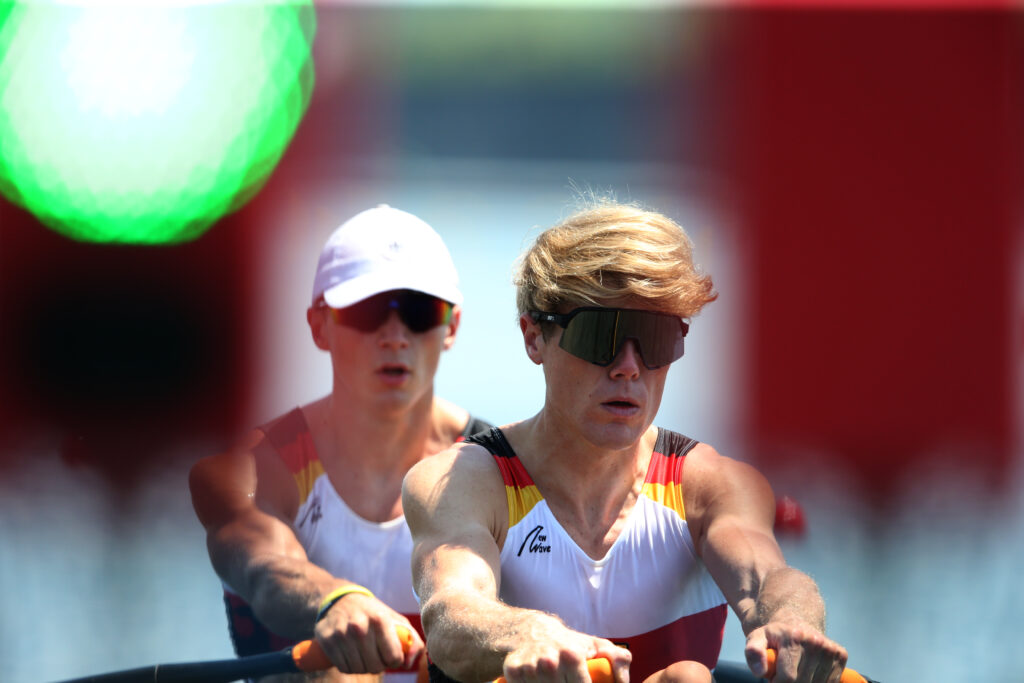
Definitely the favourite for gold in this boat class are the Irish – Paul O’Donovan and Fintan McCarthy. They lined up in Heat Two, sitting in lane four. The starter sounded and it was a flurry of blades with Uruguay going off at 46 strokes per minute. They took an early lead, almost half a boat length over the rest of the field. Cetraro Berriolo and Kluver Ferreira of Uruguay must have been savouring this moment in the lead as the Irish began to move. They now had the fastest pace and moving with Ireland was Poland and the Czech Republic.
Back in Rio O’Donovan took silver in this boat class with his brother. Now joined by McCarthy their speed looks to have improved and they are the reigning World Champions and won World Cup II this year. Ireland now moved away from the rest of the field with Poland and the Czech Republic neck-and-neck for second. Poland’s Mikolajczewski and Kowalski last raced together at the 2020 European Championships and finished fourth. The Czechs qualified for the Olympics at the Final Olympic Qualification Regatta in May and they were now leaving Poland in their wake to grab second. Ireland had won.
Heat Three featured Rio Olympic bronze medallists Strandli and Brun of Norway. They were the most experienced in this race by far. Belgium went out rating 45, but it was Brun and Strandli that got the lead at the start. Spain slotted into second with Belgium in third. But the race was very tight, with just two seconds between the top five boats. Then Norway showed their skills and pulled out to an open water lead. At the half way point Spain remained in second with Belgium in third. Belgium’s Tim Brys and Niels van Zandweghe finished fifth at World Cup II and they were now moving through Spain with Canada joining in the tussle. There were now three boats going for second place and these three boats had closed on Norway.
Spain couldn’t handle the pace and Belgium moved into second. They had gone early and they still had a lot of racing to do. Belgium was closing on Norway with Canada now overtaking Spain. At 250m to go Belgium nearly had the Norwegians. Norway got to the line in first.
Qualifiers: GER, ITA, IRL, CZE, NOR, BEL
Women’s four (W4-) – Heats
For the first time since the 1992 Olympics the women’s four is back. They had two heats with the top two in each heat getting to go directly to the final. In Heat One it was a tight start with the Netherlands having a small margin. The Dutch have good form, they won two of the World Cups this year. The Dutch – Hogerwerf, Florijn, Clevering and Meester – looked relaxed as they continued to lead over Great Britain and China. The Chinese then pulled into second and looked to be closing on the Netherlands.
China had qualified through the Final Olympic Qualification Regatta in May and before that these Chinese rowers all raced in different boats at the 2019 World Rowing Championships. The Dutch then pushed away from China with Great Britain not able to keep up with China. The Netherlands and China now looked in solid qualifying spots. The Dutch sprinted to the line and destroyed the field going over 18 km/hr through to the line. The Dutch had scored an Olympic Best Time of 6:33.47. They take it off the fastest time at the Barcelona Olympics.
The reigning World Champions, Australia lined up in Heat Two. The boat included two rowers who raced in the women’s pair earlier today the whole team being Stephan, Popa, McIntyre and Morrison. Rating in the mid 40s, all boats got away cleanly with Australia starting to inch out into the lead early on. Ireland and Romania were the next up. But there was little in it at the 500m mark with just over two seconds separating the entire field.
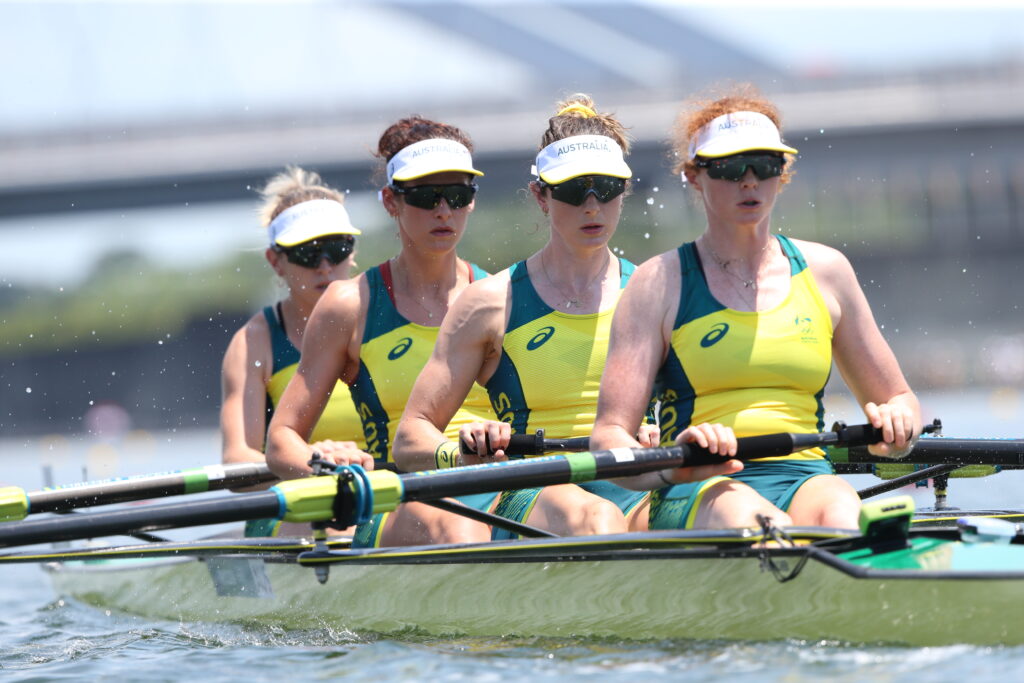
Australia then started to move away from the field with Ireland’s Keogh, Lambe, Murtagh and Hegarty in second. Ireland won the Final Olympic Qualification Regatta in June. Romania was in third and still within striking distance. The three leading crews looked to be dropping the rest of the field – the United States and Denmark. Ireland now had clear water over Romania and was closing on Australia. Both Australia and Ireland were rating 37 and at the 1500m mark it looked like Ireland could take Australia. But did they need to?
Australia held off Ireland, responding to the Irish pace. Ireland came back and pushed Australia some more. Both boats were sprinting. There was nothing in it at the line. Australia got there on the surge. Australia had set the new Olympic Best Time, taking it from the Dutch in the former heat in a time of 6:28.76.
Qualifiers: NED, CHN, AUS, IRL
Men’s Four (M4-) – Heats
This boat class had two heats and the top two boats in each heat would get to go directly to the final. South Africa rated 56 off the start in Heat One, but it was the United States who were the first to show. Stroked by 21-year-old Clark Dean, this is the first international race for this crew. Australia was at 41 and they took over in the lead. Australia and the United States now looked to be pushing away from the rest of the field. Australia is the world silver medallists and they also own the Olympic Best Time.
The Australian boat is the top men’s sweep boat for their country – Purnell, Turrin, Hargreaves and Hill. They now moved away from the US and this field became very spread out. Romania now tried to come back on the United States crew of Dean, Grady, Weiss and Reed. The Netherlands were up with Romania as the US began to come back on Australia. The US definitely had a good push. They were gaining with every stroke. Australia responded and upped their stroke rate to maintain the lead. What a great finish. The US kept on coming. Australia reacted back. No one could touch these two leaders. Australia had held off the US.
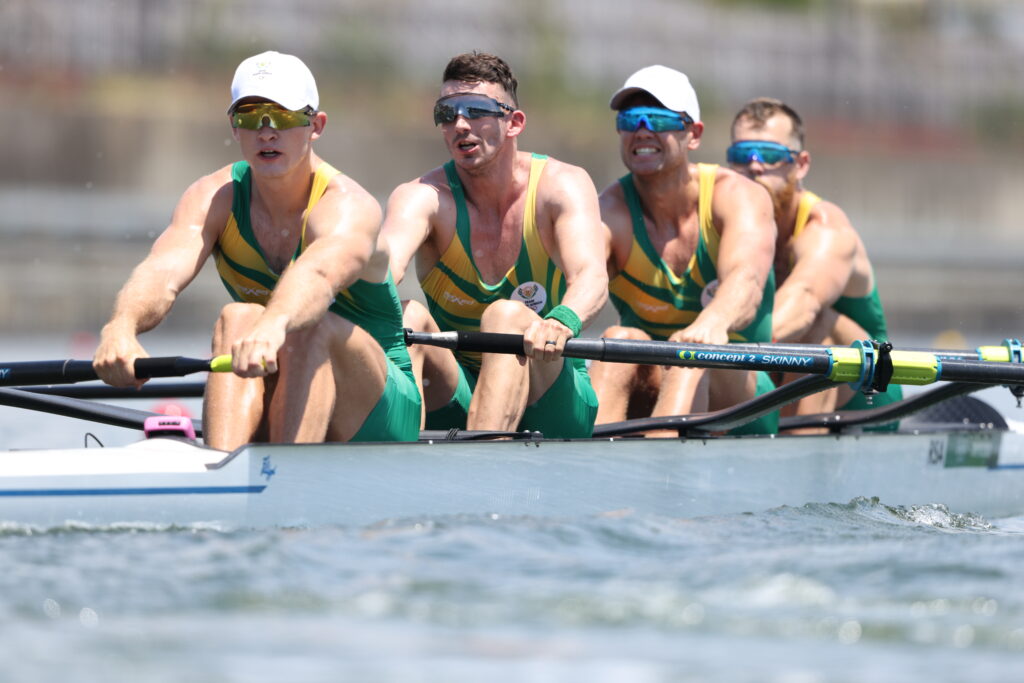
Heat Two had winners of World Cup III, Italy and winners of World Cup II, and European Champions Great Britain as well as the 2019 World Champions Poland. This boat class really was quite open with no dominating boat. But the British must have been the favourites with their incredible winning pedigree in this boat class. The start was a little late, but just a fraction. The boats got ready and away they went with Great Britain taking the early lead. Behind them it was a practical line. What a start by the British! They had nearly a boat length lead with 400m raced. But the Canadians came back and slotted into second. This Canadian crew qualified in June through the Final Olympic Qualification Regatta. Now Italy pulled up. The Italians went off the line with the highest stroke rate and they had ‘settled’ the highest at 42 strokes per minute. Italy was now in second with Poland pulling ahead of Canada to take third.
Meanwhile Great Britain held their handy lead. Italy was having a great race. They were at 41 strokes per minute and continued to gain on Great Britain. These two boats were leaving the rest of the field behind. Italy was at 42 to Great Britain’s 40. The sprint was on. Great Britain held off Italy. No one has more Olympic golds than Great Britain in this event. Great Britain crossed the line in first, one second slower than Australia in the previous heat.
Qualifiers: AUS, USA, GBR, ITA
Men’s eight (M8+) – Heats
This boat class had seven boats, two heats and the winner of each heat would get to go directly to the final. Heat one had Germany who has dominated the last Olympic quadrennial, but have not had such a good 2021 so far with Great Britain beating them. Australia has not raced since 2019 nor had the Americans. The United States went out quickly and took the lead. They led the Germans through the 300m mark. Germany was in second with Romania and Australia back in third and fourth.
The United States and the Germans were travelling at the same speed but the United States continued to lead. This was a German vs USA race and neither boat was giving up. The United States had half a second over Germany coming into the last quarter of the race. Germany now moved back. With just 250m left to race Germany had the lead. The United States pushed back. The Germans had timed it to perfection and crossed the line in first. What a great race.
The Netherlands took the lead early in Heat Two. New Zealand and Great Britain were left to battle it out behind them. THrough the middle of the race, New Zealand turned on the gas and with long, controlled strokes they pushed their way up. The British seemed to fade as New Zealand drew closer to the Dutch. Ramping up to the sprint, New Zealand had the best boat speed. They were starting to move back on the Dutch, but were running out of water. Across the line, the Netherlands held on, half a boat up on New Zealand, with Great Britain taking a disappointing third.
Qualifiers: GER, NED
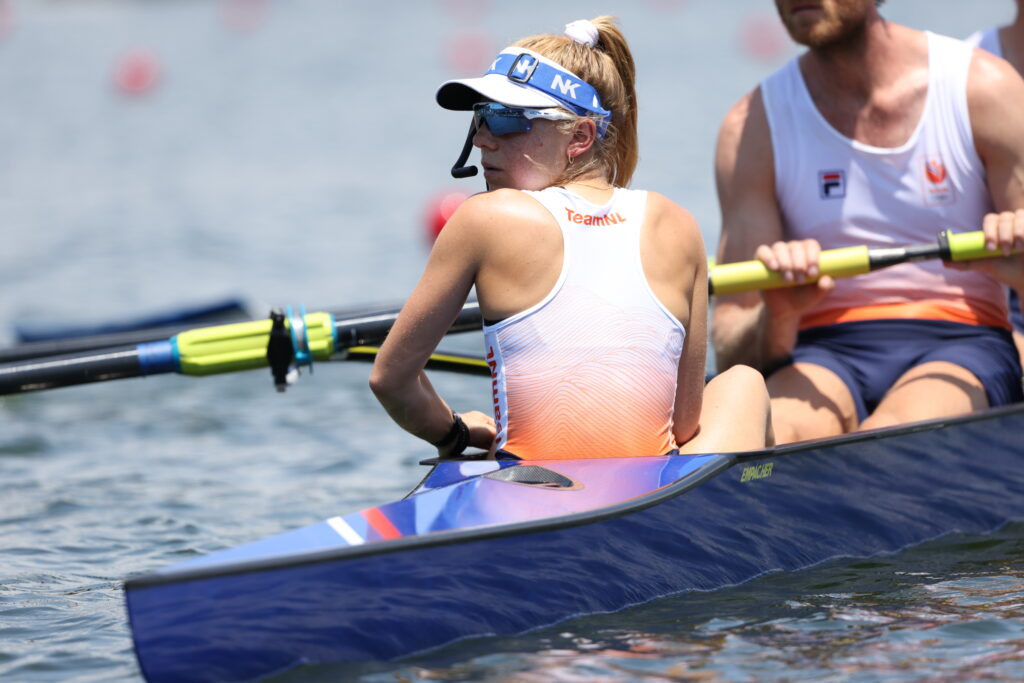
Women’s eight (W8+) – Heats
The goal was to be first in each of the two heats for a direct path to the final. Heat One was delayed due to a fault in the start system. They got under way and China led at the start over World Champions New Zealand. China qualified through the Final Olympic Qualification Regatta over Romania. China continued to lead with Canada in second and New Zealand in third. China and Canada then moved away from New Zealand and went head-to-head at the front of the field. New Zealand tried to get back into the picture and through the middle of the race New Zealand was gaining. In the New Zealand boat, two of their crew – Gowler and Prendergast – had already raced earlier in the day in the women’s pair.
China continued to lead and Canada started to take on China with New Zealand coming at them. There was nothing in it with 500m left to row. The sprint was on. Canada was at China as the New Zealand crew started to charge. Three boats were equal. New Zealand took the lead with 250m left to go. Canada overtook China and were taking on New Zealand. It was New Zealand at the line.
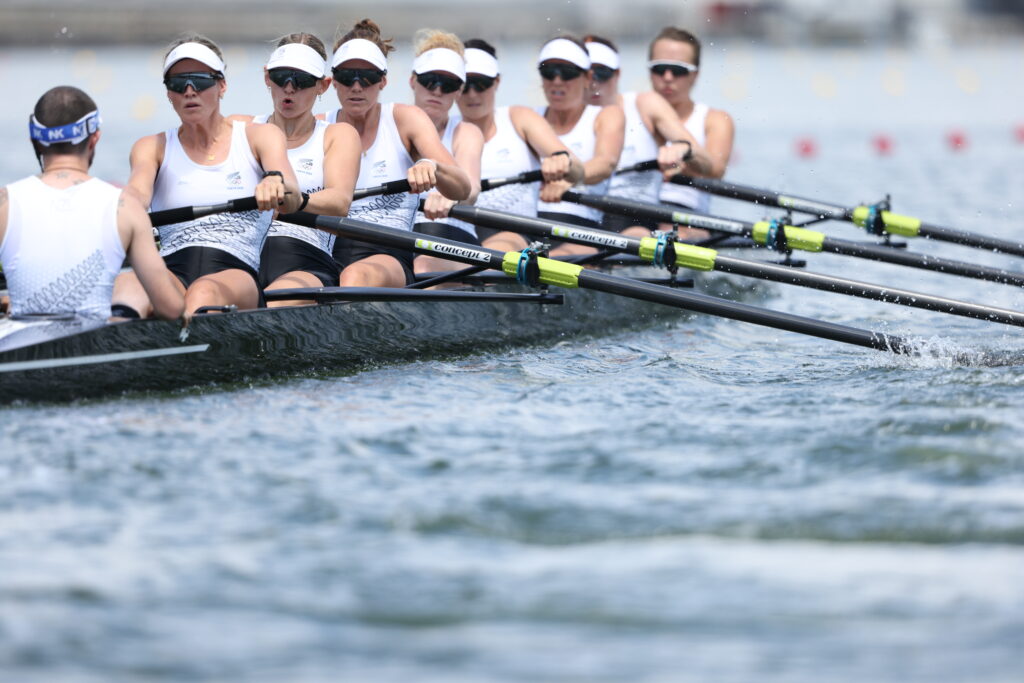
Heat Two was between Romania (two-time European Champions), Australia and the Olympic Champions the United States. Romania had the highest stroke rate at the start with 48 strokes per minute. Romania got into the lead with Australia following in second and the United States looked to have been caught out. Romania had a canvas lead over Australia as the United States did a surge and overtook Australia. They all went under the bridge at the 700m mark and you could hear the intensity in the voices of the coxswains. Coming into the half way point Australia was dropping back as the United States took the lead. Could Romania hold on in the second half? The US was at 37 strokes per minute. They had World Record holder on the indoor rower, Brooke Mooney sitting in the boat. The US now had the edge over Romania and started to pull away. The final sprint was on and the US looked unstoppable. The US were travelling at 19.1 km/hour. Romania pushed back. It was too late. The United States had grabbed the first place and a spot in the final.
Qualifiers: NZL, USA

